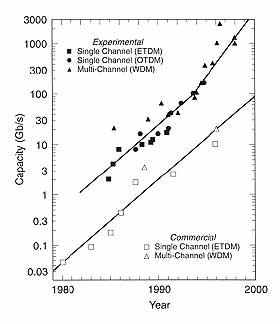VI.7. Telecommunication
An ongoing revolution occurring in the field of telecommunications is the development of small laser diodes and high capacity optical fibres. Without optical fibre telecommunication devices the highly convenient availability of huge amounts of information at comparatively low costs, as provided by the Internet, would not be possible.

Fig. VI.21. During the last two decades, optical fibre capacity has increased by a factor of about 1000. For comparison, commercial state of the art wire connections range in the region of about 0.1 Gigabit per second (Gb/s).
The measurement of the power output of laser diodes or fibers is a daily routine in the field of telecommunication components testing. Optical power meters using a bare detector claim high sensitivity but at a cost of potential measurement inaccuracies caused by the effects of polarization, local saturation, signal 'bounce-back' and beam misalignment. Also, the use of large size photodiodes required to reduce source to detector misalignment, increases cost.
A welcome alternative is the integrating sphere which is able to collect all of the source optical radiation output independent of beam geometry. In the world of photonics, the integrating sphere is well known for its ability to reliably and accurately measure total flux from fibers, laser diodes, lasers, LEDs and any other optical radiation or light source. Since all of the incoming signal is captured and reflected inside the sphere multiple times before reaching the baffled detector mounted to it, the adverse effects of polarization, local saturation, signal 'bounce-back' and beam misalignment are reduced.
Tutorials

